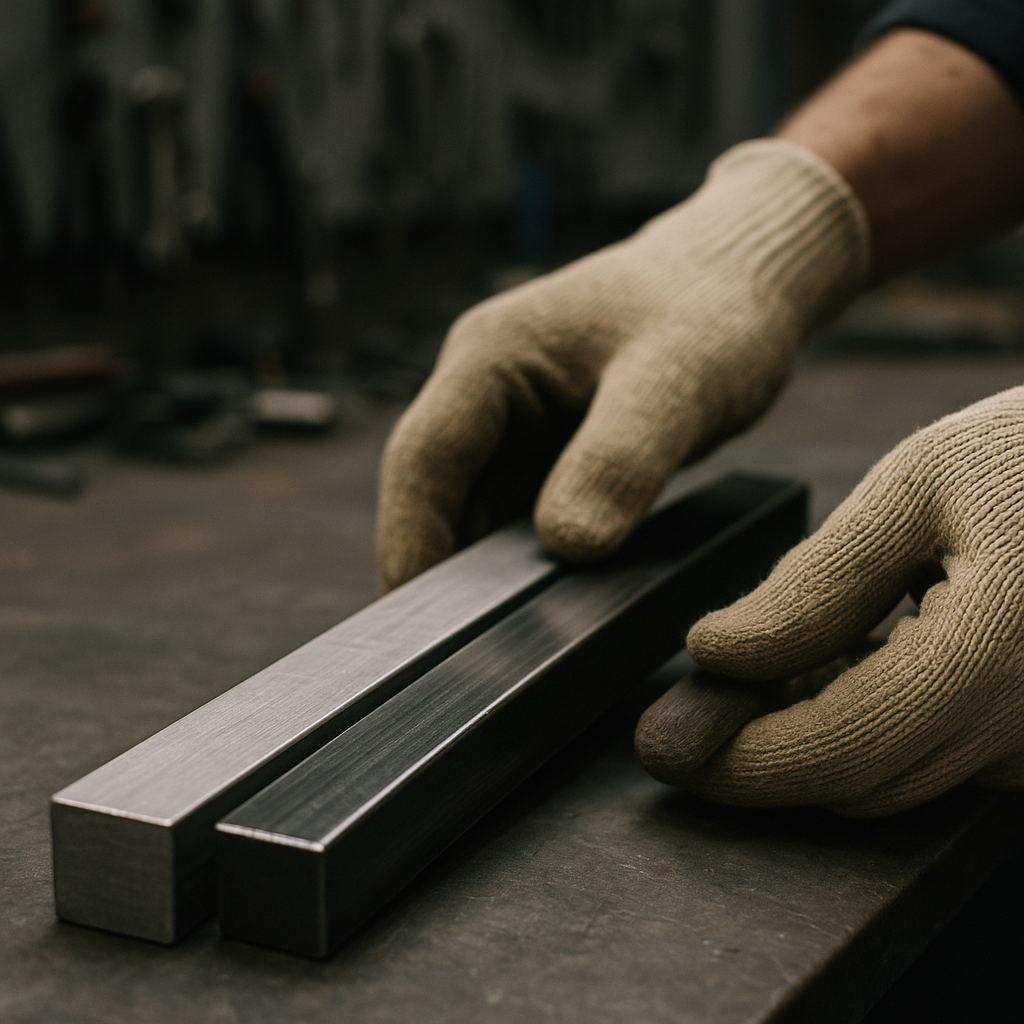5901 Botham Jean Blvd, Dallas, TX 75215
How to Tell the Difference Between Aluminum and Steel
July 18, 2025A pile of scrap metal sits before you. Some pieces shine silver, others appear dull gray. But which are aluminum and which are steel? This seemingly simple question has significant implications for recyclers, scrap sellers, and project managers across industries.
Identifying aluminum versus steel is crucial, impacting the value of scrap metal, the success of recycling efforts, and the outcome of construction or manufacturing projects. Though they may appear similar to untrained eyes, these metals have vastly different properties, applications, and values in the recycling market.
For scrap metal collectors, distinguishing between aluminum and steel can lead to substantial differences in payment. Steel typically commands lower prices, while aluminum—lighter, non-magnetic, and more costly to produce from raw materials—often yields higher returns.
How Can Visual Inspection Help Differentiate Aluminum and Steel?

Visual inspection is a practical initial method for distinguishing between aluminum and steel during the recycling sorting process. Several visual characteristics can help identify these metals without specialized equipment.
Color Differences
The most immediate indicator is color. Aluminum typically has a lighter silver-gray appearance with slight bluish undertones. Its surface often appears brighter and more luminous, especially in natural light. In contrast, steel usually shows darker grayish tones with a muted, sometimes slightly brownish hue. This distinction becomes more apparent when examining clean, unoxidized surfaces.
Stainless steel presents a unique case with its more polished, reflective finish that can sometimes be confused with aluminum. However, stainless steel typically has a warmer, slightly yellowish silver tone compared to aluminum’s cooler coloration.
Surface Texture and Finish
Touch and texture provide valuable clues. Aluminum generally features a smoother, more uniform surface texture. When new or recently manufactured, it often has a satiny finish that feels slick to the touch. Steel frequently presents a rougher texture with visible grain patterns. This difference is more pronounced in weathered materials, where steel might develop a pitted or textured surface.
Surface imperfections also tell a story. Aluminum tends to show scratches more readily but maintains its overall appearance. Steel often displays more resilience to surface scratching but may develop characteristic wear patterns over time.
| Color | Aluminum: Lighter silver-gray with bluish undertones; Steel: Darker grayish tones, sometimes with a brownish hue |
| Surface Texture | Aluminum: Smoother, satiny finish; Steel: Rougher, with visible grain patterns |
| Oxidation | Aluminum: Whitish-gray protective layer; Steel: Reddish-brown rust (non-stainless) |
| Weight | Aluminum: Light; Steel: Heavy |
| Magnetic Properties | Aluminum: Non-magnetic; Steel: Magnetic |
| Applications | Aluminum: Used in areas needing lightweight materials; Steel: Used for heavy-duty items |
Common Applications as Identification Clues
Recognizing typical applications can help identify these metals. Heavy-duty items like appliances, industrial equipment, and kitchenware commonly use stainless steel for its durability and heat resistance. The substantial weight of these items indicates their steel composition.
On the other hand, products where weight reduction matters—bicycle frames, aircraft components, outdoor furniture, and some automotive parts—often use aluminum. The noticeably lighter weight of these items suggests aluminum construction.
In packaging materials, aluminum appears in thinner forms like beverage cans, foil wrap, and some food containers. Steel packaging typically feels heavier and sturdier, exemplified by food cans and some industrial containers.
Oxidation Patterns
How these metals age provides additional visual cues. Aluminum forms a whitish-gray oxidation layer that appears as a dull film over time. This aluminum oxide protects the metal from further corrosion. Steel, particularly non-stainless varieties, develops reddish-brown rust patterns. Stainless steel generally resists visible oxidation but may show subtle discoloration in harsh environments.
These visual inspection techniques prove invaluable in recycling operations, allowing for initial sorting before more definitive tests like magnetic separation. While visual cues alone cannot ensure perfect identification, they provide essential preliminary guidance that improves recycling efficiency and material recovery rates.
What Simple Tests Can Determine if a Metal is Aluminum or Steel?

The magnetic test is the most reliable and straightforward method. Steel contains iron, making it magnetic, while aluminum does not have magnetic properties. To perform this test, place a refrigerator magnet against the metal. If it sticks firmly, it’s steel. If there’s no attraction, the metal is likely aluminum. This test is immediate and requires only a common household magnet.
Weight comparison offers another effective method of identification. Aluminum is significantly lighter than steel, about one-third the weight of steel for the same volume. Lift similarly sized pieces of both metals, and the difference is obvious. This weight disparity becomes even more apparent with larger objects. For example, an aluminum pot feels much lighter than a steel one of the same size.
The scratch or key test can also help distinguish between these metals. Aluminum is softer than steel, so it’s easier to scratch. Use a key to drag across the surface of the unknown metal. A deep scratch with minimal effort suggests aluminum, while steel will resist scratching and may require more pressure to mark.
For those wanting to try a slightly more advanced test, the spark test can be definitive. When held against a grinding wheel, steel produces bright orange sparks, whereas aluminum generates few to no visible sparks. However, this test requires a grinding tool and should be performed with proper safety precautions.
The sound test is another simple identification method. Tap the metal with a small object like a coin or key. Aluminum typically produces a duller sound compared to the more resonant ring of steel. This difference is due to the varying densities of the metals.
These straightforward tests make metal identification accessible to everyone. By using common household items like magnets, keys, or even just by lifting and comparing weights, you can accurately determine whether a metal is aluminum or steel before recycling it.
| Test | Method | Aluminum Result | Steel Result |
|---|---|---|---|
| Magnet Test | Place a magnet on the metal | Non-magnetic | Magnetic |
| Weight Comparison | Compare weight of similar sized pieces | Lighter | Heavier |
| Scratch Test | Use a key to scratch the surface | Scratches easily | Requires more pressure to scratch |
| Spark Test | Grind against a wheel | No visible sparks | Bright orange sparks |
| Sound Test | Tap with a small object | Duller sound | Resonant ring |
Understanding these differences helps ensure metals are properly sorted before recycling, which is crucial for maintaining the quality of recycled materials and maximizing their value in the circular economy. The more accurately we can identify and separate these metals, the more efficiently they can be processed and used in new products.
What Advanced Techniques Can Professionals Use to Identify Aluminum vs Steel?

Professional recyclers and metal workers often need to distinguish between aluminum and steel with certainty. While basic methods like visual inspection and magnet tests work for preliminary sorting, advanced identification techniques provide more definitive results in industrial recycling operations.
Conductivity Testing
Electrical conductivity testing is one of the most reliable methods professionals use to differentiate between aluminum and steel. Aluminum conducts electricity significantly better than steel. A multimeter with a conductivity setting can quickly verify the metal type.
To perform this test properly, professionals ensure both test probes make good contact with a clean metal surface. Aluminum will show a much higher conductivity reading than steel. This method is particularly valuable in recycling facilities where quick, non-destructive testing is needed for large volumes of metal.
Spark Testing
Spark testing involves grinding the metal against a wheel to create sparks. The appearance of these sparks can help identify the metal type and even specific alloys. This test requires experience to interpret results accurately and should only be performed by trained professionals using proper safety equipment.
When grinding steel against a wheel, it produces characteristic short, bright orange or yellow sparks that branch into fine lines. The higher the carbon content in the steel, the more numerous and brighter the sparks. In contrast, aluminum produces few to no sparks when ground, as it has a lower ignition temperature.
Safety warning: Conduct spark testing in areas free from flammable materials. Protective eyewear and clothing are essential, as metal particles can cause serious eye injuries.
Chemical Testing
Chemical tests provide definitive identification but require careful handling of reactive substances. Professional recyclers may use diluted hydrochloric acid to distinguish between aluminum and steel. When applied to aluminum, the acid causes bubbling and produces hydrogen gas as aluminum reacts with the acid. Steel may show some reaction but typically at a much slower rate.
For more precise identification of specific steel grades, phosphoric acid tests can identify low-chromium stainless steels through visible bubbling. Similarly, silver nitrate solutions can help distinguish between aluminum and magnesium (which sometimes appear similar) by leaving a black residue only on magnesium.
Safety warning: Conduct chemical testing in well-ventilated areas with appropriate protective equipment, including gloves, eye protection, and appropriate clothing. These tests should only be performed by trained professionals familiar with proper chemical handling procedures.
X-Ray Fluorescence (XRF) Analysis
For industries requiring precise metal identification, X-ray fluorescence analyzers provide detailed compositional analysis. These handheld devices emit X-rays that cause the metal to fluoresce, revealing its elemental makeup. XRF analyzers can identify not just whether a metal is aluminum or steel but also the exact alloy composition.
This non-destructive testing method is especially valuable for quality control in manufacturing or analyzing high-value scrap. While the equipment is expensive, the speed and accuracy make XRF analysis cost-effective for large recycling operations.
These advanced methods enable recycling professionals to sort metals with high accuracy, ensuring proper processing and maximizing the value of recovered materials. Each technique has specific applications depending on the volume of material, required accuracy, and available resources.
| Method | Description | Efficiency | Applications |
|---|---|---|---|
| X-Ray Fluorescence (XRF) | Emits X-rays to cause fluorescence in metals, revealing elemental composition. | High precision, rapid results. | Quality control, scrap metal analysis. |
| Laser-Induced Breakdown Spectroscopy (LIBS) | Uses laser to create plasma on the metal surface, analyzes emitted light for composition. | Fast and portable for on-site testing. | Field testing, industrial applications. |
| Optical Emission Spectroscopy (OES) | Electric energy excites metal atoms to emit light, analyzed for elemental makeup. | Excellent for detecting light elements in steel alloys. | Laboratory analysis, in-depth alloy testing. |
| Conductivity Testing | Measures metal’s ability to conduct electricity. | Reliable for quick identification. | Recycling plants, industrial sorting. |
Conclusion: Mastering Metal Identification

Accurately identifying metals, particularly aluminum and steel, is a valuable skill that combines simple techniques with advanced methods. The visual, physical, and technological approaches we have explored provide a comprehensive toolkit for distinguishing between these common materials. From basic magnet tests to sophisticated XRF analysis, each method serves a specific purpose in metal identification.
The ability to confidently identify metals offers numerous benefits in both professional and personal contexts. For recycling operations, proper identification maximizes value and efficiency. In manufacturing and construction, selecting the right material ensures structural integrity and performance. For DIY enthusiasts, this knowledge aids in selecting appropriate materials for specific applications and potentially increases the value of scrap metal collections.
For assistance with recycling needs or to learn more about proper metal identification and recycling, contact Okon Recycling at 214-717-4083.
